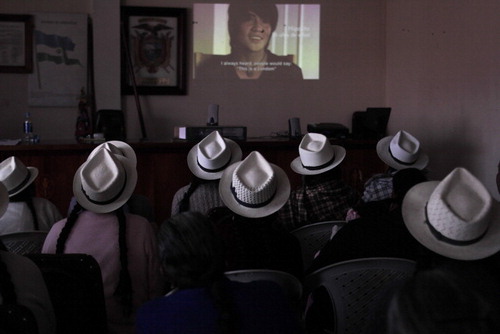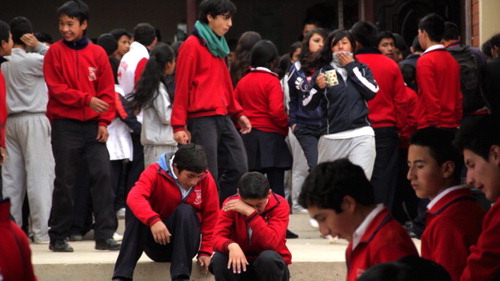This is a report by the first author about the making of two videos about adolescent sexual health in Ecuador in 2011 and 2012.
Thus, I recruited Dylan Howitt, an experienced documentary filmmaker, to capture local perspectives on this perceived crisis in adolescent sexual and reproductive health. For both films, we took an exploratory and unscripted approach, letting the interviewees' answers guide the filmmaking process. We explained to the participants in both films that the resulting work would be shared with Project CERCAFootnote* consortium members, within Cuenca and the Azuay province (and possibly at a national level), posted to YouTube, and used in future presentations of Project CERCA's work at conferences and in articles. We asked everyone to be as honest as possible, given that these films could help inform, and hopefully improve, the state of adolescent sexuality and health education and health outreach projects in the region. In turn, we stayed as true as possible to the contradictory attitudes and misinformation on these issues that people shared in on-camera interviews, rather than editing the material to reflect “best practice”, for example, referring to sexually transmitted infections as enfermedades (diseases).
Voces de Cuenca (Voices from Cuenca)
Filmed in Cuenca, Ecuador, March 2011
https://www.youtube.com/watch?v=L8o0kFfUddY
The first film, Voces de Cuenca, was created with the aim of giving young people the chance to speak directly to those responsible for designing adolescent sexual and reproductive health (SRH) intervention strategies in Cuenca, (e.g. my colleagues on Project CERCA, a European Union FP7-funded research intervention), in addition to NGOS, municipal and regional representatives of education and health departments. The voices we hear include adolescents from a participatory-ethnographic research workshop that I conducted, young adults who had received training in adolescent SRH outreach from a previous IPPF-funded project in Cuenca, English language students we met on the street who exchanged speaking on camera for an interview with us, and the brother of an acquaintance.
Tres Generaciones (Three Generations)
Filmed in Chiquintad, Ecuador, May-July 2012
The second film, Tres Generaciones, formed part of the in-depth ethnographic research I carried out over five months in 2012 in the semi-rural parish of Chiquintad (pop. 4,073)Citation3, one of three Project CERCA intervention sites in Cuenca. For this film, which required in-depth interviews and observational filming over the course of two months, I selected participants with whom I had developed close relationships through my work with the Elders Club of Chiquintad, the Chiquintad Library, and the Chiquintad Technical High School. Having witnessed the usefulness of visual ethnography in stimulating dialogue and debate with Voces de Cuenca, this second documentary was created as a jumping-off point for discussions on cultural and generational taboos surrounding talk and advice-giving on sex and sexuality within families.
Chiquintad is a place of young mothers, grandparents, children and adolescents (41% of the population are under 18), but very few adult men (due to outward-bound migration, principally to the United States). Formal education levels are abysmal (just 17% have completed secondary school).Citation3 The famous paja toquilla (“panama” hat weaving industry) that used to provide a viable cash flow for subsistence farmers living in the valley is now reduced to a trickle of tourist dollars. One remaining source of pride, as any resident will tell you, are the 19 times a chiquiteña has won the chola cuencana title (a beauty and culture pageant). In day-to-day life, however, the only women in Chiquintad still wearing the traditional full skirts, embroidered blouses and tightly woven and bleached hats of the local chola uniform are in their late 50s or older. In the span of just three generations Chiquintad has been transformed from a rural agricultural village with no health post, no high school, adobe farm houses, crippling poverty, and no direct transport to Cuenca, to being on the edges of Cuenca's urbanization, now with a technical high school, internet cafes, concrete and glass multi-story houses built with dollars earned abroad, and five-times hourly bus service to central Cuenca.
The three individuals in the video (grandmother, mother, daughter) are not meant to be representative “types”, but their stories give some insight into the radical transformation of sexual and reproductive health attitudes and knowledge over a 40-year period. Although not all three live in Chiquintad, they are all intimately connected to this place. Doña Rosa Esperanza Alvarado Uquilima grew up in a house one block off the central plaza, dropped out of school at the age of nine due to a serious bout of reumatismo (possibly rheumatic fever), and helped her mother to raise her nine younger siblings. Lic. Soñia Astudillo is head librarian of the one-room Chiquintad Public Library, helping to coordinate community activities such as the weekly gatherings of the Elders Club in the parish hall. Hipolito Cabrera, an active participant in Proyecto CERCA's young people's clubs, attends Chiquintad Technical High School, travelling daily by bus from a neighborhood located roughly at the halfway point between the village and Cuenca's industrial park. All the participants in Tres Generaciones have since seen the documentary and approved of the content (although Doña Esperanza complained that she looks too skinny, having been filmed just months after the death of her mother).
Unlike Voces de Cuenca, which was quickly assembled and informally shared, Tres Generaciones was meant to be a more reflective piece. The idea was to provide historical and cultural context to a public health project aimed at transforming the way that families talk about issues related to adolescent sexual and reproductive health. The film reflects my belief that to begin to change these day-to-day conversations about acceptable and expected behaviour of young people, as they enter a period of sexual exploration that may lead to a potential hardening of gender norms, it is important for them to know more about what previous generations have lived and experienced themselves.
Over the last three months, I have shown Tres Generaciones to mixed groups of parents, grandparents and adolescents in all three Project CERCA sites (Managua, Nicaragua; Cochabamba, Bolivia; Cuenca, Ecuador). Surprisingly, the ability of the film to open up conversations on the nature and limitations of communication within families on sex and sexuality was equal in all three settings, despite substantial cultural and socio-economic differences between groups. In Cochabamba, both parents and young people could not believe that the documentary was filmed in another country, so similar to their own lives were the stories told. In Managua, focus group participants were stunned by how much they had in common with families thousands of miles away, in particular the total absence of sex education or contraceptive knowledge among adults aged 40+. In response to the film, people (young, old, in-between) talked openly about the advice they have been given about sex and contraception by their elders and their peers, health providers admitted the difficulties with which they talked about contraception or healthy sexual behaviour with their own children, and parents took solace in challenges faced by Sonia and in Esperanza's shock at being witness to such a changed world.
Whether these films themselves can serve other adolescent sexual and reproductive health projects remains to be seen. My experience showing them in distinct Central and South American contexts suggests that they can be useful for adolescent educators within a Latin American and United States Spanish-speaking context.
On the basis of my experience, I strongly encourage programmers and advocates in other parts of the world to incorporate visual methodologies into their education and outreach efforts. Although both our videos are anchored in the particular reality of life in Ecuador's southern sierras, they contain a message that is equally relevant to young people and their families anywhere in the world. Adolescents are not a self-contained target group or a universe of knowledge, attitudes and practice unto themselves. Though they may disagree with or rebel against the social and cultural norms and expectations of their parents and elders, they nevertheless exist in a multigenerational world that places many expectations on them. Both films, in different ways, are an attempt to get people of all ages who are experiencing generation gaps to throw a line across to the other side.
Acknowledgements
Project CERCA partners include: South Group, Bolivia; University of Cuenca, Ecuador; Kaunas University of Medicine, Lithuania; National Autonomous University of Nicaragua, Nicaragua; Instituto Centro Americano de Salud, Nicaragua and University of Amsterdam, Netherlands. The project is coordinated by the International Centre for Reproductive Health, Belgium, and funded by the European Commission FP7 framework.
Notes
* CERCA stands for Community-embedded reproductive health for adolescents in Latin America. www.proyectocerca.org.
References
- UN Population Fund. State of the World's Population 2012. www.unfpa.org/webdav/site/global/shared/documents/publications/2012/EN_SWOP2012_Report_1.pdf
- Instituto Nacional de Estadísticas y Censos. Censo de población y vivienda 2001.
- Instituto Nacional de Estadísticas y Censos, ibid, quoted in: Informe País: Proyecto CERCA, Universidad de Cuenca, February 2011.

